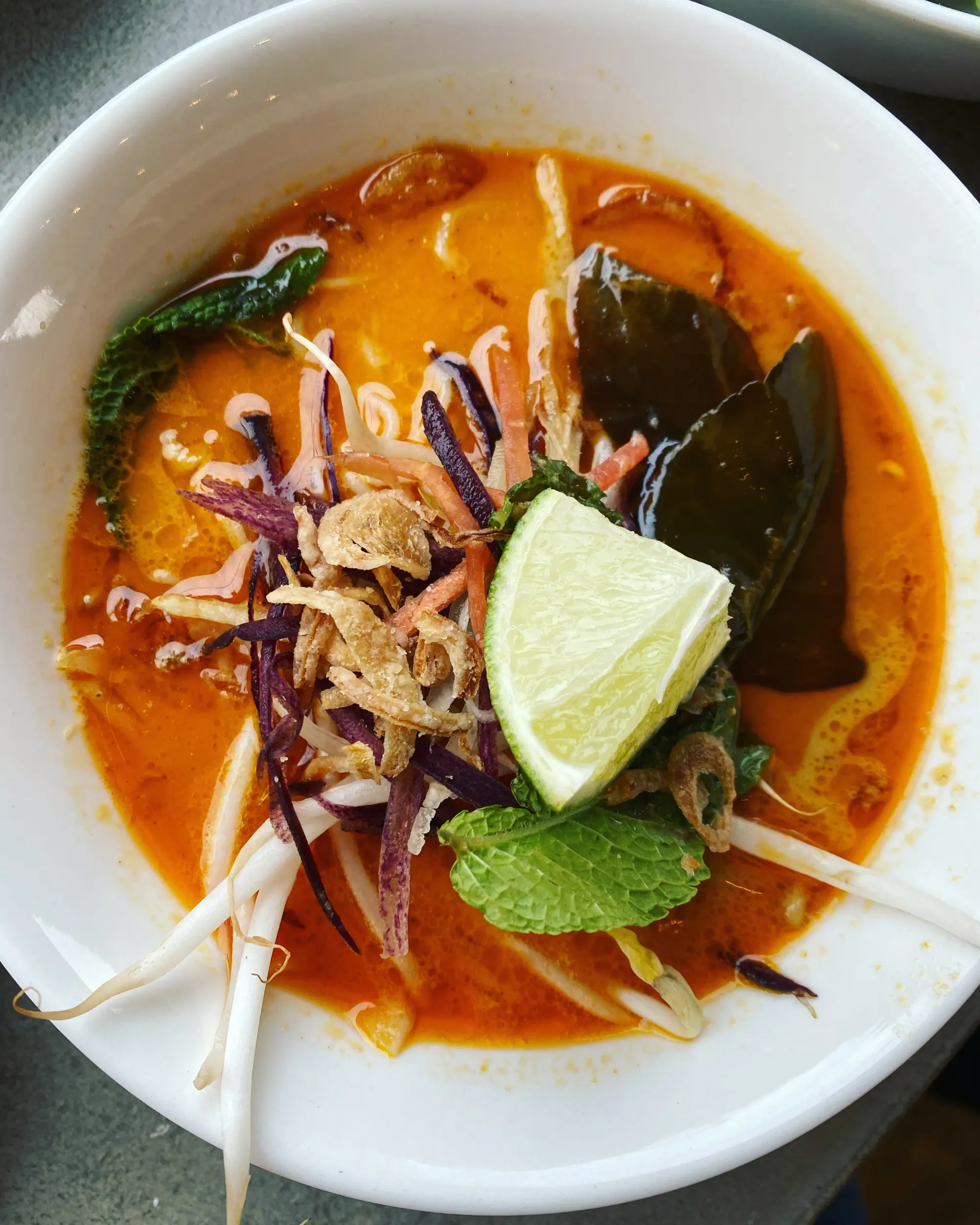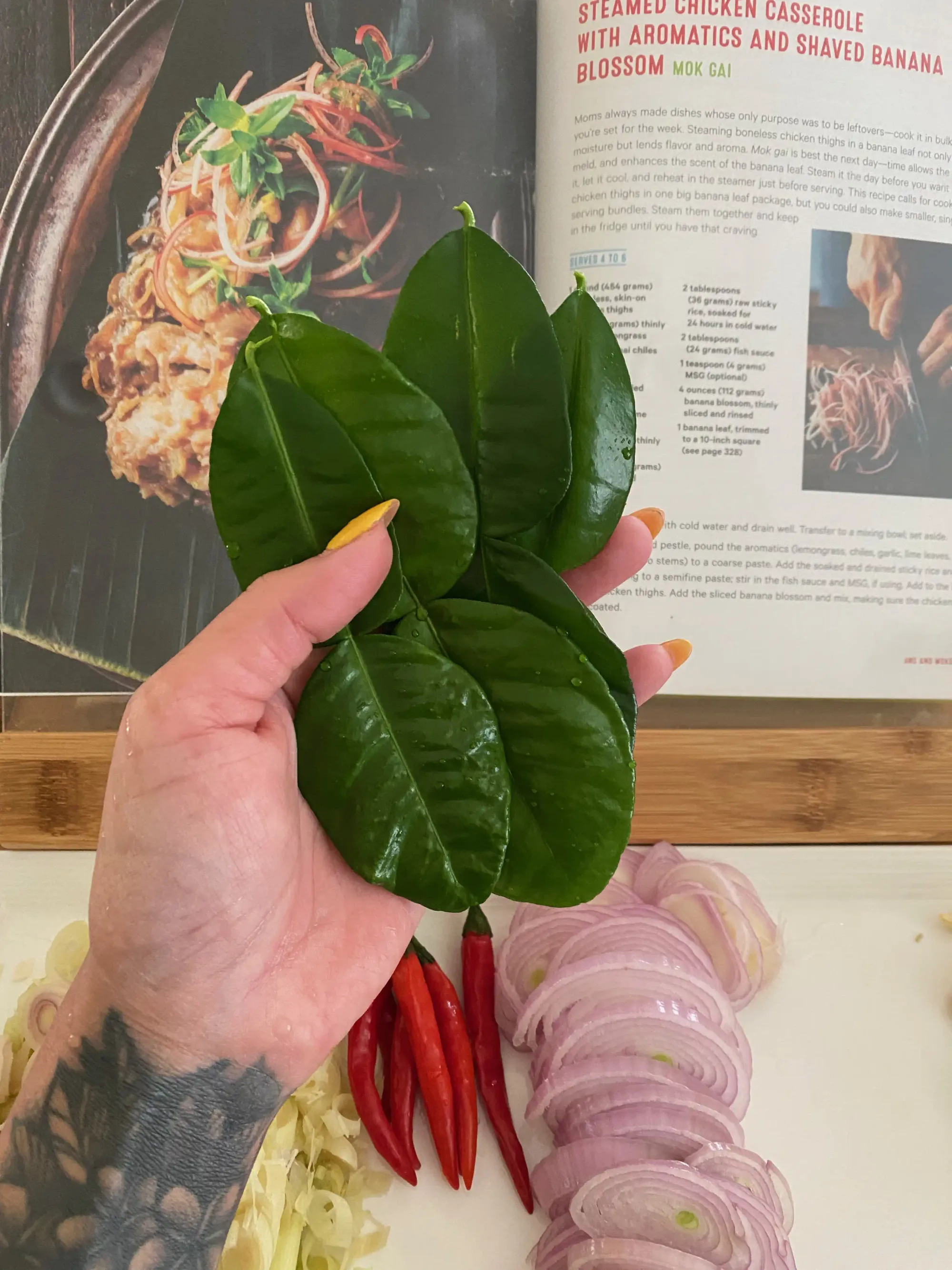essential-leaves

by Lasamee Kettavong
I’ve loved khao poon for as long as I can remember. Khao poon is the shortened title I’ve given to one of my favorite Lao meals: it’s a red curry and coconut milk based soup that is served with rice vermicelli or somen noodles and an abundant selection of fresh vegetable and herb toppings to customize one’s bowl. The soup broth is flavored by the red curry, punched up by fresh ginger and garlic sauteed before combining with the curry and coconut milk.
What distinguishes this soup broth from all the rest is the makrut lime leaves that simmer in the broth; without them, it’s just a red curry coconut milk soup but with them, it’s khao poon. The lime leaves impart a delicate perfume to the broth and flavor it with a depth of citrus. If absent, you will notice.

Makrut lime leaves have to be carefully plucked from the tree. There’s a small thorn between the leaf and the stem that will prick you something fierce if you’re not mindful of it. Nature has a way of preserving itself, as do we humans. You have to accept the entire tree, thorns and all. Wishing for a different existence for the tree does you no good, and without its thorns, it simply wouldn’t be a makrut lime tree. Through honoring and understanding the ingredients with which I cook, I’ve learned a lot in addition to knowing about the essential components of a complex broth – I’ve learned a lot about people. There’s a lot of time to think when you’re in the kitchen, preparing dozens of servings (which requires a lot of repetitive movement and a lot of time). I wasn’t in a place to make khao poon, or any Lao food for that matter, for my father before his passing, and I’ve only just begun to accept the thorns with which he existed. He had a temper that would turn into rage. His complex PTSD rendered it impossible to coexist in a home with him peacefully, and so we never got to know one another. Wishing for a different way of his being and our relationship has done me no good, so I’ve embarked upon a journey of understanding and forgiveness. Much of this is accomplished in the kitchen. Some of it is accomplished while keeping my makrut lime tree alive.
Of all the meals that I would come home to at 10 PM after a long day at school and then at my cashier job at a local grocery store, khao poon was my favorite. I would be delighted if there was a pot of khao poon broth on the stove and the noodles and toppings left out on the dining table for me. My mother was usually already asleep, but still just awake enough to know that I’d arrived safely before falling into a deeper slumber.
Khao poon was an “I love you, please eat, and good night” between she and I – when it was just the two of us remaining in our family home in Dallas for some time. In college, I would crave khao poon and try to replicate this meal with the red curry I would find on the shelves at Sack and Save behind my dorm building. To no avail. I mean no offense to the Thai Kitchen brand, and I have often found myself grateful for it when needing particular sauces or ingredients in a pinch, but it just didn’t cut it for me. For one, the curry lacked key ingredients that would only be found in a specific brand that my mother used, and secondly, food tastes different when your mother prepares it for you.
8 years post-early college days, in January 2019, I’d find myself making a giant batch of khao poon for a dinner party of twenty guests. At this point, I still hadn’t learned to simplify and focus on making *one* signature dish for this kind of event. I was scrambling the morning of dinner party day, even with the help of my partner, to get everything done.
It seemed like the water for the noodles took triple the time to boil, and the coconut milk I’d chosen did not want to reduce down to the creamy-almost-oil that is important to the flavor of the soup broth for the life of me. At the end of the night, loading equipment, pots and pans, and food containers back into the car, I realized.
I’d forgotten the critical ingredient: the makrut lime leaves. None of the guests, aside from the close friends who were there that I’d confided in, knew of my error. But I was deeply ashamed. January 2019, it occurs to me now, was also the last time that I saw my father in-person, about a week after the dinner party in which I had forgotten the most essential ingredient.

This past December (2023), I’m counting makrut lime leaves like they’re cash – 32 leaves for 8 gallons of liquid, with about a dozen fresh leaves and a package of dried ones in hand just in case the broth needed adjusting during service at our first pop-up market in over a year.
I’d launched Good & Golden, my Lao food and culture business, in December of 2021 and had learned a lot from the events we’d hosted and services we’d started to offer.
Good & Golden served khao poon to guests at True Leaf Studio’s night market during Denton’s Wassail Fest & Tree Lighting event and sold out within a couple of hours. Our return after a year away felt triumphant.
In the stillness after the chaos of prepping for, working an event, and serving Lao food to friends and strangers alike, I pause to reflect and practice gratitude for the woman who taught me to make khao poon and where I came from. And though prickly and sometimes a pain (and often the one who inflicted it), I can’t neglect to honor my father and what he has passed on to me as well, no matter our complex relationship. Or maybe, in spite of it.
where to find the essential leaves
Although Denton appears to have a couple more specialty food stores opening up (Bhavya, Basmati Grocer’s), I’ve found that you have to drive either to Carrollton or to Haltom City to find fresh makrut lime leaves that make khao poon so special.
You are able to order dried makrut lime leaves online, but in this case, I do like to stick to the phrase, “fresh is best.” It’s worth it.
If you’re very ambitious and can plan to be there during New Year’s festival weekend, you can purchase a makrut lime tree from the farmers who set up as vendors at the temple for Lao New Year. Then you’ll have fresh lime leaves at your disposal. Mind the thorns.


